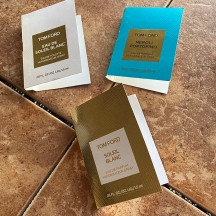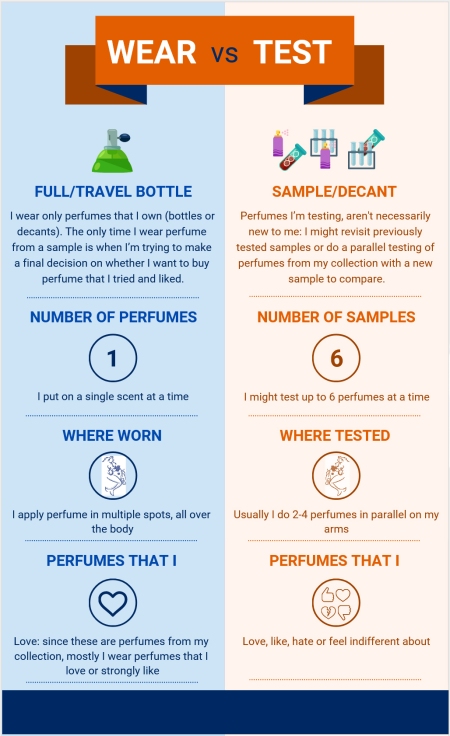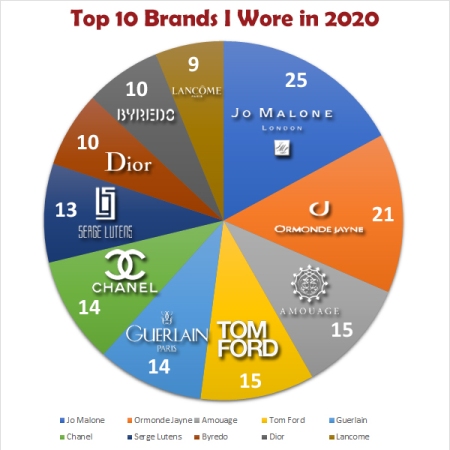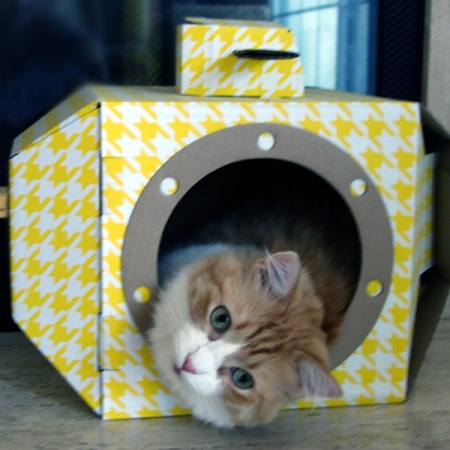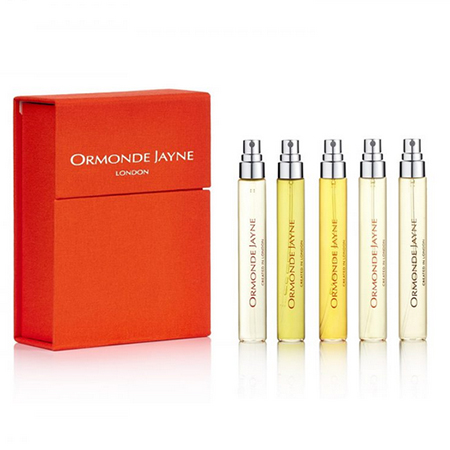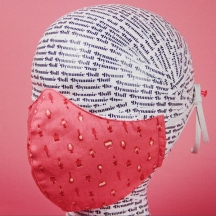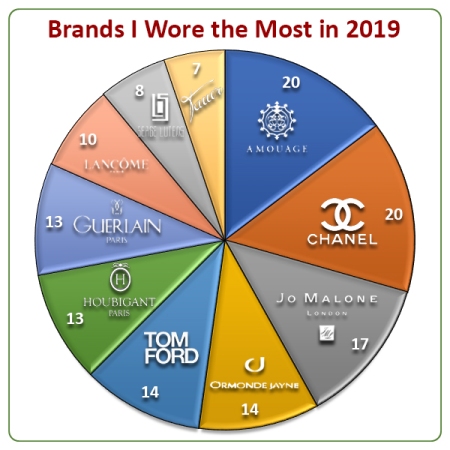If not to count job or user interviews I conducted as a part of my job, this is my first ever interview with someone in the perfume industry. And if 10 years ago, when I started this blog, anybody would have told me that I would be in a position to interview Linda Pilkington, a creator of Ta’if, my second all-times favorite perfume, I wouldn’t have believed them.
Last November, I was offered an opportunity to participate in the series of mini-interviews Ms. Pilkington was conducting as a part of the Worldwide launch of La Route de la Soie, a new collection that was created to celebrate Ormonde Jayne 20 years of perfumery. But since by that time I’ve already bought and reviewed the collection on my blog, I asked if I could do something slightly different – 20 Questions for 20 Years interview. And Ms. Pilkington agreed.
With the end-of-the-year rush and all holidays it took me a while to transcribe the conversation we had and put it into a post format. And then I thought that it would be very fitting to publish it for my blog’s 10th anniversary, since, as I told in the story for my blog’s 3rd anniversary, Ta’if was that perfume, from which my journey down the rabbit hole of niche perfumery started.
Also, I think it is serendipitous that Narth came up with the Saturday Question: Which Perfumer Would You Like to Meet In Person? around this time because, not being a fan-girl-type, the only perfumer I’ve ever wanted to chat with was Ms. Pilkington and only because of her role in creating perfume I fell in love with and everything that followed. We didn’t physically meet but it was the next best thing that can happen these days: we talked for more than an hour in Zoom.

On the photo above please meet my Ta’if family starting from the very first decant from The Perfumed Court and including the latest addition – Ta’if Intensivo, about which I’ll probably do a separate post later.
* * *
Since I knew that predominantly people who were already familiar with the brand would be reading this interview, I skipped the traditional “let’s educate our readers about the brand” part and asked those questions that I was curious about and answers to which I didn’t know.
Ormonde Jayne: 20 Questions for 20 Years
Undina (U): Do you wear perfumes daily?
Linda Pilkington (L): I do. Even through the lockdown I wore perfume every day. I decide what to wear based on the combination of “How do I feel?”, “What is my day ahead?”, “What am I going to wear?” and a little bit to do with weather. For example, if I have a day when I know that I have to be on the ball, I put on Ormonde Woman: it makes me feel powerful; it makes me feel like I’m in control; it makes me feel that I’m my own person.
U: Do you re-apply your perfume during the day?
L: Yes, I do. In my office in the boutique I have that “emergency kit” next to my computer – a hairbrush, lipstick and perfume. If I’m called downstairs to chat with somebody, it takes about 5 seconds – brush my hair, put lipstick on, apply perfume – and I’m ready.
U: I realize that it’s like asking a mother which of her children she loves more, but still – is there any one perfume in the line that is especially dear to you? It’s not necessarily perfume that you like the most, but maybe there was something significant during the creation process, or the perfume that holds strong emotional connection?
L: It’s not Ormonde Woman, even though I like it, and everyone in the industry recognizes that it’s a good perfume. Many years ago, in my travels in the Middle East, I had come across oud. I was quite intrigued by that horrible pungent scent that people actually wanted to wear. I found it disgusting but decided to investigate because nobody wore it as perfume in Europe.
I brought some oud from Laos back to my studio in London, and we tried to decide what to do with it. “Nobody will want to wear that,” I said… so we put 0.06% into Ormonde, and we decided then to make Ormonde Woman and Ormonde Man (because before it was just Ormonde). Back then in Europe nobody had put oud into a fine fragrance. A journalist from Financial Times got interested; I sent her samples, I sent her pictures, and she featured it in the How to Spend It Magazine, back in 2004. So, Ormonde Man put the company on the map. And people from the perfume industry were saying: “We’d like you to consult about it; we want to know what it is.” So, I think that was my defining moment.

U: So, you are that person who is responsible for the expansion of agarwood in European perfumery in the last 15 years!
(Linda laughs)
U: While most perfumes are “unisex” and can be worn by anybody who likes them, by traditional classification there are more feminine-leaning perfumes in your collection. If you agree with this statement, why is that? Was it an economical decision (women buy more perfumes)? Or is it more natural for you to create feminine perfumes? Or is there some other reason?
L: You’re right: there are slightly more floral, oriental perfumes – I’d say, floriental is the palette I desire. But we did that “gender-free” aspect to the company through experience. When we started, we had a masculine and feminine side. But after two bad experiences with the clients to whom we had sold perfume after they wore it on their skin and liked it, but later discovered online that perfume they bought was on the feminine side and got upset, we realized the sensitivity of this issue. So, I contacted our web designer and told him to take off the “feminine” and “masculine.” We retrained all the staff not to use these descriptions. And if you’re asking about the sales, the women/men customers’ ratio is 60/40.
U: Is there any single perfume that outperforms all others in terms of popularity/sales?
L: The number one in all countries is Montabaco Intensivo. We have good sellers in different countries. For example, in Russia, they absolutely adore Champaca: for every 100 bottles of Ormonde Woman, we sell 1000 bottles of Champaca. In America, Ormonde Woman and Frangipani. In Europe, it’s Osmanthus, Ta’if and Ormonde Woman. But Montabaco Intensivo is in the top three in every country.

U: While creating perfumes, do you ever have to compromise between what you like and what you think will sell better?
L: I always go with my nose, with what I like… except that quite often I’m “compromised” by IFRA. The original Amber Royal was outstanding. But it failed [the standards] completely. So, the best way to deal with it is to know the quantities you will be allowed to use and work around it.
U: Are there any perfume notes that you don’t like and because of that will not use in your perfumes?
L: I can’t work with tuberose in full quantity, and I would never do a full-blown tuberose perfume.
U: A woman after my own heart! I can’t stand tuberose.
L: It’s so heady, it’s so sickly, that it makes you feel a little bit ill. I can work with it in small quantities, but… No, I can’t take tuberose.
U: Was it for the same reason that you never did lily perfume? You have lily as a candle, but not as perfume.
L: No, it’s not that. I do like lily. But it’s too standard. I’ve never managed to achieve interesting lily perfume. With lily, after the top note dries off, it automatically goes back to standard lily – which is not really Ormonde Jayne. If you’ve got your signature Osmanthus, Frangipani, Ta’if, Tolu, Sampaquita or Champaca, all very beautiful, well put together, balanced, creative, artistic, abstract perfumes with lovely names. You can’t have a lily suddenly stuck among them. It’s not the style of the house. I tried. I put it with all kinds of ingredients, but in 5 minutes it’s a standard lily.
U: Why do you release perfumes in collections instead of just one new release at a time?
L: What happens is: we have a number of territories throughout the World. And they all want exclusivity. It’s hard. So, when we do a collection, it allows us to offer them a subset of it – what will work well for their territory.
U: How do you decide what perfumes to add to the line next? Are you filling in the gaps? Or something else? What goes into that decision?
L: I get feedback from my team, they are telling me if people keep asking about an ingredient. Sometimes I realize that something’s missing from our repertoire. For example, in my Signature collection I’d like to add a good musc perfume at some point when it feels right to me. And I’d like to add good patchouli perfume. And sometimes somebody sends you an oil that is interesting. It’s not something you’ve been looking for, not what I really need, but I’m particularly taken by it.
U: When will be the next new release?
L: I’ve got a couple of oils at the moment, and I’m launching two perfumes next year – they are practically finished now. I think they are absolutely fantastic. We won’t launch them at the same time. They’ll go into the Signature Collection, and we will launch them in 2021 as soon as we can travel again. I think they are absolutely stunning. Of course, some of my partners can still say to me: “They are not for my market.” I can’t speak for everybody, though I’ll try to persuade them because I know people would love these.
U: That takes me to my next question about different markets. I can’t believe people in the US do not want candles. But your US online store doesn’t have them. Why?
L: That’s not because they don’t want them. The rules and regulations are changing all the time. We have our own candle factory, so we were putting a lot of oil in candles, because we want them to smell nice. When those were tested, we were told that there was too much oil, and we had to change something. Since I didn’t want to compromise, it took me almost 18 months to recreate my candle oils so that they are just as good. And then I had to change the wick to be compliant. We just started making them again, so at the moment they are just in the UK. Maybe in a year and a half we’ll be able to supply them again.
U: What about hair mist?
L: With hair mists it’s, again, what our partners want. They have just that much space for the brand, and they say that they can sell our perfumes much faster than our hair mists. And they have their rent to pay…
U: In the past, there were body products in coordinated scents – shower gels, bath oils, if I’m not mistaken, even body lotions. Recently, I haven’t seen them either as stand-alone products or in sets. Do you have any plans for making more body products in future?
L: Before all the rules regulations I used to do all my shower cream and body lotions in my kitchen with an electric Moulinex baking mixers, not even industrial ones. 20 years ago I could do a body lotion myself and put it in a pot. But you’re not allowed to do it any more. It is expensive to have someone else to make all of my perfumes and body lotions. And then my partners would say: “For every 50 bottles of Ta’if perfume I sell, I sell 1 bottle of the body lotion. So, instead of giving up a shelf space to body lotions, I’d rather give it to perfume.”

U: Your regular line and made-to-measure – is the difference only in concentration, or do you “tweak” the formula as well?
L: The formulation is the same, and you chose 40 or 50 percent, whatever is allowed. It’s the same formula, but it smells different because at different concentrations different nuances come through. And, of course, it’s a lot more tenacious. And, when people get their favorite perfume at higher concentration for themselves or as a gift to loved ones and have their initials engraved, it makes that perfume more special for them.
U: Is there any classic or modern perfume about which you thought: “I wish I would have created it!”?
L: Not really… When I was younger, I fell in love with Diorella. I used to wear it all the time and thought it was the most magnificent perfume. I still have a bottle of Diorella in my bathroom now because I just love the smell of it. When I was a teenager and up until probably 18-20, I wore Diorella and made sure that all my boyfriends wore Eau Sauvage, also made by Edmond Roudnitska. I thought that it was a perfect match: I wear Diorella, you wear Eau Sauvage, and together we’re gonna smell so magnificent. So, maybe I wish it had been my creation.
U: Your collection is quite extensive now. Are there any plans to discontinue any of the current scents or concentrations?
L: We’d never discontinue any perfume. First, we like all the formulations. Second, it costs too much to bring the formula to market. So, sometimes when we want to reign in, we would just put some perfumes into our library. So, they just “go to bed,” they are going to get a little bit of a sleep, and they stay there. But 2-3 years down the road we might re-introduce them, maybe with a different name if a partner wants it for their market.
U: Do you have any plans to increase your brand’s presence on IG or YouTube?
L: I’m not too technically savvy, so my goddaughter takes pictures of our perfumes and posts them on our Instagram account. I don’t have any social media myself. So, I rely on my goddaughter: she’s level-headed, and she understands the philosophy of the company. I don’t think I’ll ever become a YouTube person. If anything, maybe for Cooking with Fragrance (you know, my Gourmande Jayne). Our social media person started building up this aspect, but we’re doing it slowly. We don’t want just to be doing endless “offers” because I think it can backfire. We’re really tiny, so we do not want to go “too commercial.”
U: And the final but important question. Do you share your dwelling with any furry family members?
L: Yes! Two cats, called Teddy and Freddie. They are from the cat home. I got them when they were kittens. They are brothers, but they don’t look like each other. One is a big fat ginger cat. He looks like Garfield. And the other one is black with green eyes. They snuggle up in front of the fire, sleeping in the daytime but turn into psychotic murderers by night. They go out every night. They kill anything that comes into our garden. They are working cats.

Teddy, the ginger one, is very greedy. As he goes along, everybody likes to stroke him, he stops and lets them do it. And then he goes to the restaurants, down the steps to the kitchen, all feed him. And he just works his way down the street getting fed.
U: My cat Rusty is really food-oriented, so if he had been permitted to do something like that, by now he probably wouldn’t have been able to walk.
L: Teddy is getting a bit big. I might have to put him on a little regime.
U: And my last question: Where do you see your brand in 5 years?
L: Hopefully, it still will be my brand. And it will be just bigger, and better, and more beautiful. It’s still privately owned today, after 20 years, and it stays that way. I enjoy what I’m doing. I feel quite lucky: I have great relationships with my partners. We meet with each other all around the world. So, it’ll be the same company as you know today but with a little bit more presence.
* * *
U: And now, concluding my 10th Blog’s Anniversary post, I want to ask myself: Where do you see Undina’s Looking Glass, in 5 years?
U: Health and life permitting, hopefully, still here. Based on decades of experience, I don’t expect to stop loving perfumes. Will I want to write about them? Will I have any stories to tell or numbers to crunch? Will there still be anyone who prefers to read about perfumes rather than watch videos and scroll through beautiful pictures? We’ll see, won’t we?






